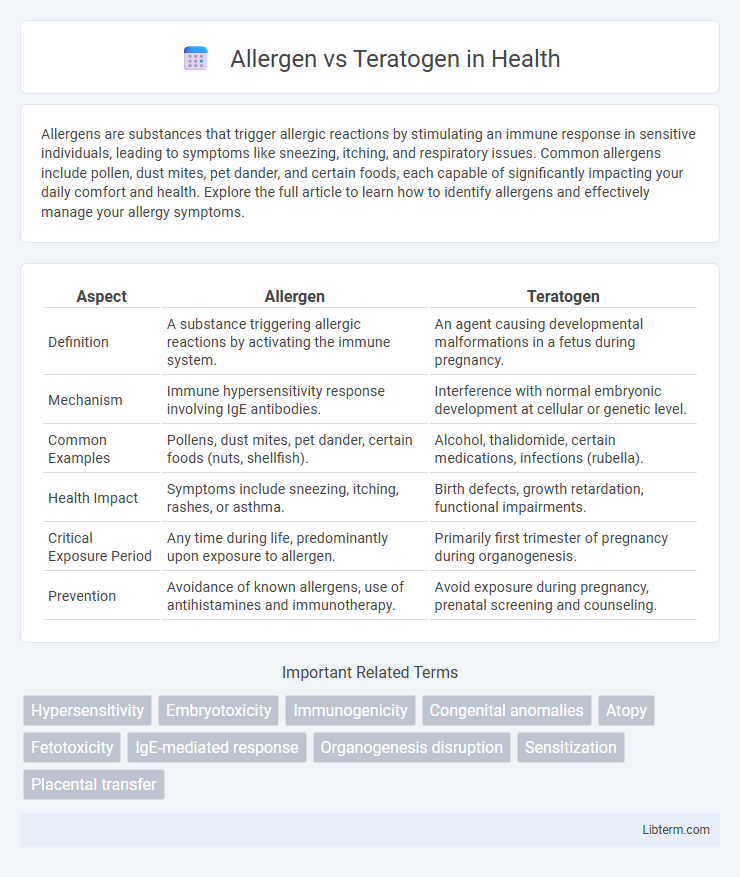Allergens are substances that trigger allergic reactions by stimulating an immune response in sensitive individuals, leading to symptoms like sneezing, itching, and respiratory issues. Common allergens include pollen, dust mites, pet dander, and certain foods, each capable of significantly impacting your daily comfort and health. Explore the full article to learn how to identify allergens and effectively manage your allergy symptoms.
Table of Comparison
| Aspect | Allergen | Teratogen |
|---|---|---|
| Definition | A substance triggering allergic reactions by activating the immune system. | An agent causing developmental malformations in a fetus during pregnancy. |
| Mechanism | Immune hypersensitivity response involving IgE antibodies. | Interference with normal embryonic development at cellular or genetic level. |
| Common Examples | Pollens, dust mites, pet dander, certain foods (nuts, shellfish). | Alcohol, thalidomide, certain medications, infections (rubella). |
| Health Impact | Symptoms include sneezing, itching, rashes, or asthma. | Birth defects, growth retardation, functional impairments. |
| Critical Exposure Period | Any time during life, predominantly upon exposure to allergen. | Primarily first trimester of pregnancy during organogenesis. |
| Prevention | Avoidance of known allergens, use of antihistamines and immunotherapy. | Avoid exposure during pregnancy, prenatal screening and counseling. |
Introduction to Allergens and Teratogens
Allergens are substances that trigger immune system reactions, causing allergic responses such as itching, swelling, or respiratory issues. Teratogens are agents, including chemicals, drugs, or infections, that can cause developmental abnormalities or birth defects during fetal development. Understanding the distinctions between allergens and teratogens is crucial for assessing health risks and preventing adverse biological effects.
Defining Allergens: Triggers and Effects
Allergens are substances that trigger immune system reactions, causing symptoms like itching, swelling, and respiratory issues in sensitive individuals. Common allergens include pollen, pet dander, certain foods, and insect stings, which activate the production of IgE antibodies and histamine release. Unlike teratogens, which cause developmental malformations during fetal growth, allergens primarily provoke hypersensitivity reactions without direct genetic or developmental effects.
Understanding Teratogens: Causes and Consequences
Teratogens are substances or environmental factors that cause developmental malformations or birth defects during fetal development by interfering with cellular growth or differentiation. Common teratogens include certain medications, alcohol, infections, and chemicals linked to congenital anomalies like heart defects, neural tube defects, and growth retardation. Understanding the timing and dosage of teratogen exposure is crucial, as critical periods during embryogenesis determine the severity and type of congenital abnormalities.
Mechanisms of Allergic Reactions
Allergens trigger immune system hypersensitivity by inducing IgE antibody production, leading to mast cell degranulation and histamine release that cause symptoms like inflammation and swelling. Teratogens do not directly cause allergic reactions; instead, they interfere with fetal development through mechanisms such as genetic mutations, enzyme inhibition, or disruption of cell signaling pathways. Understanding allergen-induced IgE-mediated pathways is crucial for diagnosing and managing allergic diseases distinctly from teratogenic effects.
How Teratogens Impact Fetal Development
Teratogens disrupt fetal development by causing structural malformations, functional impairments, or growth retardation during critical periods of organogenesis and fetal growth. Exposure to teratogens such as alcohol, certain medications, and environmental toxins can lead to birth defects, neurodevelopmental disorders, and miscarriage. Unlike allergens that trigger immune responses, teratogens directly affect cellular differentiation and tissue formation in the developing embryo.
Common Sources of Allergens
Common sources of allergens include pollen, dust mites, pet dander, certain foods like nuts and shellfish, and insect stings, all of which can trigger immune responses varying from mild to severe. Teratogens, in contrast, are substances such as alcohol, certain medications, and environmental chemicals that cause developmental abnormalities in embryos but do not typically cause allergic reactions. Understanding these differences is crucial for managing exposure risks related to allergies and fetal development.
Notable Teratogenic Agents
Notable teratogenic agents include thalidomide, isotretinoin, and certain anticonvulsants like valproic acid, which can cause severe birth defects during prenatal development. Unlike allergens that trigger immune hypersensitivity reactions, teratogens interfere with fetal growth and organ formation, leading to congenital malformations. Understanding the specific teratogenic risks of pharmaceuticals and environmental toxins is critical for prenatal care and preventing developmental disorders.
Health Risks: Allergic Reactions vs Teratogenic Effects
Allergens trigger immune system responses ranging from mild skin irritation to severe anaphylaxis, posing immediate health risks to sensitized individuals. Teratogens cause developmental abnormalities and congenital defects during fetal growth, resulting in long-term physical and cognitive impairments. Understanding the distinction between allergic reactions and teratogenic effects is crucial for managing exposure risks and protecting vulnerable populations such as pregnant women and allergy sufferers.
Prevention and Protective Measures
Preventing exposure to allergens involves identifying and avoiding specific triggers such as pollen, pet dander, and certain foods, along with using air purifiers and hypoallergenic products to reduce allergic reactions. Protective measures against teratogens emphasize avoiding harmful substances like alcohol, tobacco, certain medications, and environmental toxins during pregnancy to prevent fetal developmental defects. Both allergen and teratogen prevention rely heavily on awareness, early detection, and minimizing contact with known risk factors to safeguard health.
Key Differences Between Allergens and Teratogens
Allergens trigger immune system responses causing allergic reactions such as hives, asthma, or anaphylaxis, whereas teratogens are substances that interfere with fetal development, leading to birth defects or developmental abnormalities. Allergens include pollen, pet dander, and certain foods, while common teratogens consist of alcohol, certain medications (e.g., thalidomide), and infections (e.g., rubella). The primary distinction lies in allergens affecting immune responses in exposed individuals, while teratogens exert harmful effects during prenatal development.
Allergen Infographic

 libterm.com
libterm.com